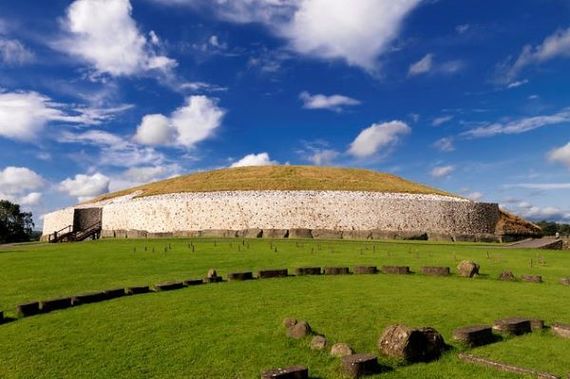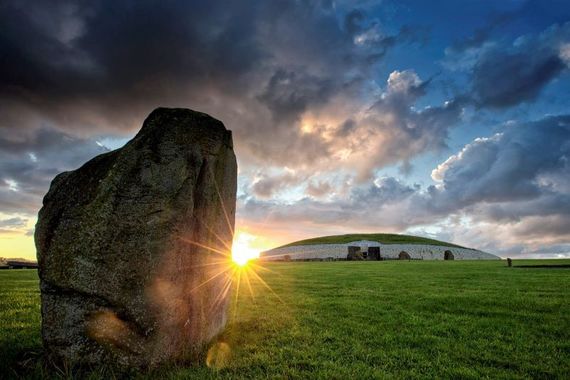This year's Newgrange winter solstice live stream, courtesy of Ireland's Office of Public Works (OPW), will begin at 08:40 UTC / 3:40 am ET on Saturday, December 21.
The Newgrange Winter Solstice live stream will be available to watch on the RTÉ News channel in Ireland on Saturday.
Worldwide, the Winter Solstice live stream will be available on the OPW YouTube page (and below!), the Heritage Ireland website, as well as the RTÉ Player, RTE.ie, and the RTÉ News app.
You can watch the Newgrange winter solstice live stream here on December 21:
The 2024 Newgrange Winter Solstice live stream will feature OPW specialists Dr. Clare Tuffy and Dr. Frank Prendergast, who will guide viewers through this spectacular event, providing unique insights and perspectives on the significance of the Winter Solstice.
“Every year, the Winter Solstice receives much attention worldwide," Rosemary Collier, Head of Heritage Services and Capital Works Delivery in the OPW, said.
"At Newgrange, visitors gather at the ancient tomb to celebrate and experience the illumination of this ancient passage tomb, just as people did over 5,000 years ago.
"I am delighted to announce that the Winter Solstice at Newgrange will be livestreamed again this year. People can share in this experience by watching the live stream online and on television in the comfort of their own homes.”

Newgrange. (Ireland's Content Pool)
Since the very first live stream of the Winter Solstice event in 2020, viewers from around the world have been captivated by the beauty and wonder of the magical event, Ireland's OPW and the National Monuments Services (NMS) of the Department of Housing, Local Government and Heritage said when announcing this year's event earlier in December.
The OPW said the Newgrange Winter Solstice live stream event allows audiences to witness this awe-inspiring event in high definition from the comfort of their own home.
View this post on Instagram
What is Newgrange?
Newgrange is a prehistoric monument built by Stone Age farmers located in the Boyne Valley in Co Meath. Along with nearby sites Knowth and Dowth, it is among the most important Neolithic sites in the world.
Dating back to 3200 BC, Newgrange predates Stonehenge and the Pyramids of Giza.
The structure itself lay hidden beneath the earth for over 5,000 years due to mound slippage, which effectively preserved it, until its rediscovery in the late 17th century, when men looking for building stone came across what they thought was a cave.
Restored to its former glory, the Newgrange mound is a solid structure that’s 250 feet across and 40 feet high, covering one acre of land. A tribute to its builders, the roof has remained essentially intact and waterproof for over 5,000 years.
Ancient carvings can be seen on many of the massive, kidney-shaped mound’s curbstones, including the triple-spiral design synonymous with Newgrange.
Local expert Michael Fox said in 2015: “Archaeologists have classified Newgrange as a passage tomb but it is more than that. ‘Ancient temple’ is a more fitting label: a place of astronomical, spiritual, and ceremonial importance.”

Newgrange. (Ireland's Content Pool)
Excavations at Newgrange
Irish archaeologist MJ O’Kelly carried out excavations at Newgrange from 1962 to 1975 and became known as the father of “New Archaeology." It was O’Kelly who produced the first scientific dates for Newgrange and rediscovered the 'roof box,' which guides the light into the chamber.
On December 21, 1967, O'Kelly was the first person to see the winter solstice display at Newgrange in thousands of years.
O’Kelly’s daughter told BBC: “He found the roof box when uncovering the roof chamber but wondered about its purpose…My mother, who worked closely with him, suggested that it might be connected with the winter solstice. And that was how he discovered it."
In his notes, O’Kelly recorded: “The effect is very dramatic as the direct light of the sun brightens and cast a glow of light all over the chamber.
"I can see parts of the roof and a reflected light shines right back into the back of the end chamber.”
His daughter, who experienced the solstice at Newgrange the following year, told the BBC: “Suddenly this shaft of light came into the chamber and hit the back wall. I remember being quietly moved – it was like someone was speaking to you from thousands of years before.
"I still see it like a picture before my inner eye – it was a golden light."

Newgrange. (Getty Images)
What happens during the Winter Solstice at Newgrange?
On the mornings surrounding the Winter Solstice, the passage and chamber of Newgrange are aligned with the rising sun.
The light enters about four minutes after sunrise, but calculations based on the precession of the Earth show that 5,000 years ago first light would have entered exactly at sunrise. That makes the solar alignment at Newgrange very precise compared to similar phenomena at other passage graves in England and Scotland.
The Winter Solstice event at Newgrange has become so popular that in 2000, the Brú na Bóinne Visitor Centre instituted a lottery system for ticketing.
In 2020 and 2021, visitors were not permitted to visit Newgrange during the Winter Solstice due to public health restrictions amidst the pandemic. In both years, Ireland's Office of Public Works facilitated a live stream of the magical event. Crowds returned to Newgrange to witness the magical Winter Solstice in person in 2022, but the OPW has continued its livestream offering.
You can watch the recording of the 2023 Newgrange Winter Solstice live stream here:
When is the Winter Solstice 2024?
In the Northern Hemisphere, the Winter Solstice occurs on December 21 or 22, when the sun shines directly over the tropic of Capricorn.
The Winter Solstice marks the shortest day and longest night of the year.

Newgrange. (Ireland's Content Pool)
How to attend the Winter Solstice at Newgrange
All access to Newgrange's chamber during the Winter Solstice is decided by lottery. However, everyone else is welcome to come and stand on the outside of the monument.
Each year, only a few dozen people are selected via lottery to visit Newgrange on the days surrounding the Winter Solstice.
Names are drawn for each of the Winter Solstice mornings, and each person drawn can bring a guest to attend on a specific morning. Some additional names are also drawn and placed on a reserve list. The reserve list is there in case someone whose name is drawn for the initial list is not contactable or else finds it impossible to travel to Newgrange on the date they have been assigned.
The place at Newgrange for Winter Solstice dawn is non-transferable. Lottery winners cannot offer their place in the chamber to someone else. There are typically about 30,000 entries for the Winter Solstice at Newgrange lottery.
The winners of the 2024 Newgrange Winter Solstice lottery were selected in October.
There is no guarantee that there will be sunlight in the chamber on any of the mornings, the event is totally weather-dependent.

Sunrise at Newgrange, Co Meath. (Ireland's Content Pool)
Heritage Ireland provided the following information for those who wish to attend Newgrange for the 2024 Winter Solstice:
- There is no car park at Newgrange National Monument. All access to Newgrange is via the Brú na Bóinne Visitor Centre (A92 EH5C).
- Limited free parking is available at Brú na Bóinne Visitor Centre. Carpooling is strongly advised. Please allow sufficient time to arrive, park and then take the free shuttle bus from the Visitor Centre to Newgrange.
- Road Closures are in place, please ensure you are familiar with these by checking the Meath County Council website and the maps below.
- No animals allowed, except for registered assistance dogs with appropriate documentation.
- Access to the Brú na Bóinne Visitor Centre to visit Newgrange is free of charge until 09.00 on the mornings of the Solstice (19 – 23 December inclusive).
- Access to the chamber inside Newgrange for sunrise is restricted to Solstice Lottery Draw Winners. If you wish to go in afterwards, you are welcome to queue on the right hand side of the entrance and visitors will be accommodated in groups.
- Brú na Bóinne Visitor Centre will be open at the following times on the Solstice mornings:
- Thursday, December 19 - 7:00 am
- Friday, December 20 - 7:00 am
- Saturday, December 21 - 6:15 am
- Sunday, December 22 - 6:45 am
- Monday, December 23 - 7:00 am
*Originally published December 9. Updated December 20.




Comments